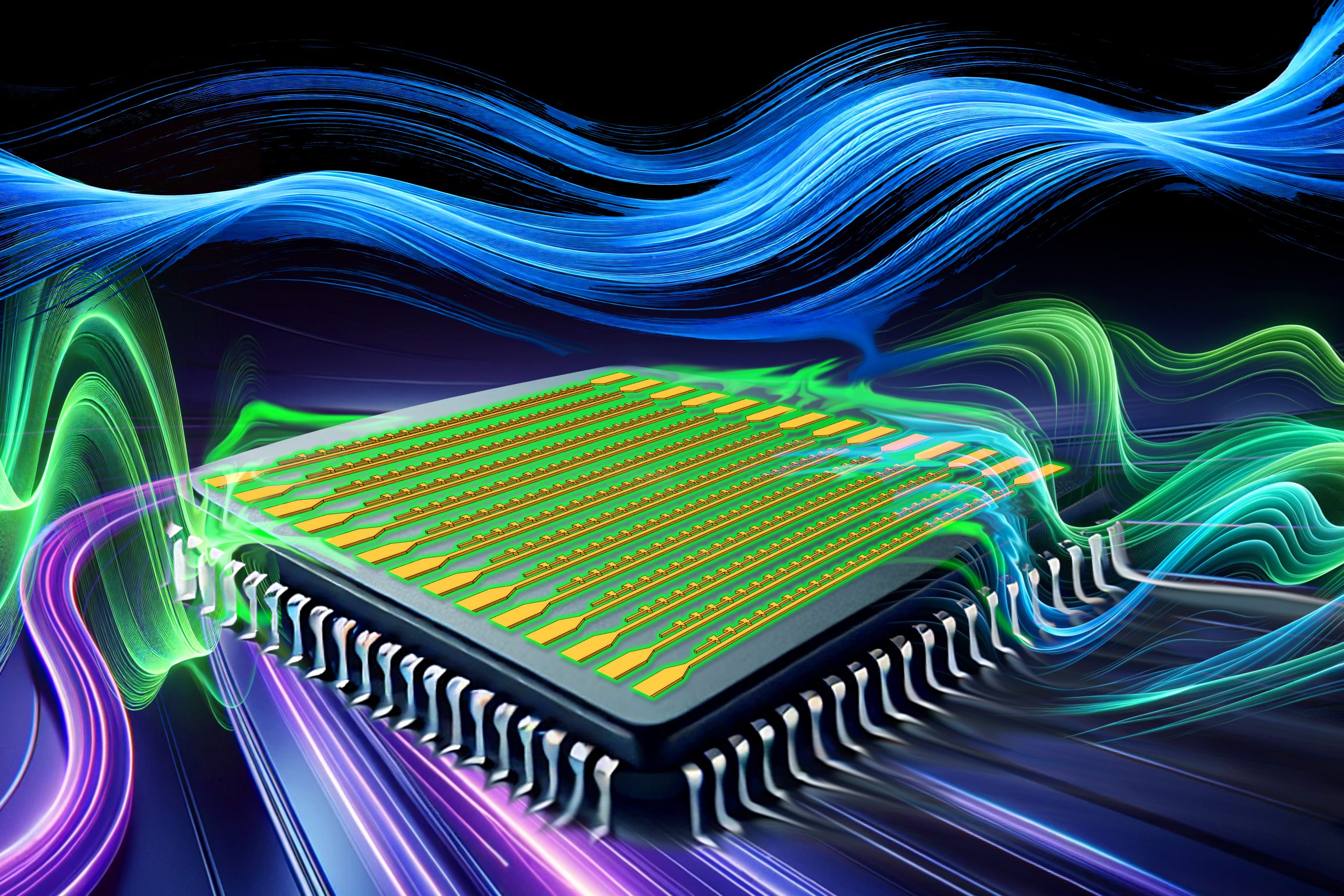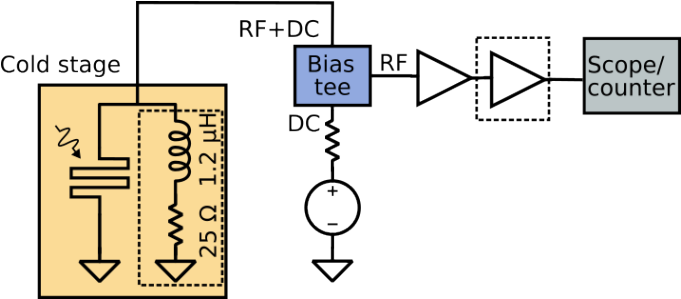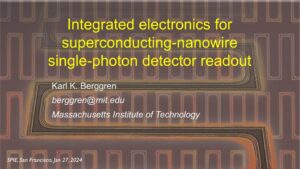News
New Publication: Lightwave Electronic Harmonic Frequency Mixing

New publication: Matthew Yeung, Lu-Ting Chou, Marco Turchetti, Felix Ritzkowsky, Karl K. Berggren, and Philip D. Keathley, “Lightwave Electronic Harmonic Frequency Mixing,” Science Advances, 10, 33, (2024)
Image credit to Sampson Wilcox.
Abstract
New Publication Featured: Nanocryotron ripple counter integrated with a superconducting nanowire single-photon detector for megapixel arrays

New publication: Matteo Castellani, Owen Medeiros, Reed Foster, Alessandro Buzzi, Marco Colangelo, Joshua C. Bienfang, Alessandro Restelli, and Karl K. Berggren. “Nanocryotron ripple counter integrated with a superconducting nanowire single-photon detector for megapixel arrays,” Physical Review Applied, (2024).
This new publication was a featured editor’s suggestion from the APS . Here is how they summarize the article:
“Scaling up cryogenic systems, like arrays of superconducting nanowire single-photon detectors (SNSPDs), requires developing cryogenic coprocessors to minimize the number of cables exiting the cryostat. This work addresses this challenge by demonstrating the ability to read out, process, encode, and store data from SNSPDs using integrated nanowire electronics. The authors design a digital counter based on nanocryotrons—three-terminal nanowire devices—to perform signal processing and digitization at low temperatures. These results suggest that nanowire coprocessors could be developed, which would benefit the application of SNSPD arrays and other superconducting platforms.”
Abstract
Decreasing the number of cables that bring heat into the cryostat is a critical issue for all cryoelectronic devices. In particular, arrays of superconducting nanowire single-photon detectors (SNSPDs) could require more than 106 readout lines. Performing signal-processing operations at low temperatures could be a solution. Nanocryotrons, superconducting nanowire three-terminal devices, are good candidates for integrating sensing and electronics on the same technological platform as SNSPDs in photon-counting applications. In this work, we demonstrate that it is possible to read out, process, encode, and store the output of SNSPDs using exclusively superconducting nanowires patterned on niobium nitride thin films. In particular, we present the design and development of a nanocryotron ripple counter that detects input voltage spikes and converts the number of pulses to an 𝑁-digit value. The counting base can be tuned from 2 to higher values, enabling higher maximum counts without enlarging the circuit. As a proof of principle, we first experimentally demonstrate the building block of the counter, an integer-𝑁 frequency divider with 𝑁 ranging from 2 to 5. Then, we demonstrate photon-counting operations at 405 nm and 1550 nm by coupling an SNSPD with a two-digit nanocryotron counter partially integrated on chip. The two-digit counter can operate in either base 2 or base 3, with a bit-error rate lower than 2×10−4 and a count rate of 107s−1. We simulate circuit architectures for integrated readout of the counter state and we evaluate the capabilities of reading out an SNSPD megapixel array that would collect up to 1012 counts per second. The results of this work, combined with our recent publications on a nanocryotron shift register and logic gates, pave the way for the development of nanocryotron processors, from which multiple superconducting platforms may benefit.
If you are unable to access the article via your library resources, you may reach out to us and we will be happy to help.
New Publication: Effects of Helium Ion Exposure on the Single-Photon Sensitivity of MgB₂ and NbN Detectors

New publication: Emma Batson, Francesca Incalza, Matteo Castellani, Marco Colangelo, Ilya Charaev, Andreas Schilling, Sergey Cherednichenko, and Karl K. Berggren. “Effects of Helium Ion Exposure on the Single-Photon Sensitivity of MgB₂ and NbN Detectors,” IEEE Transactions on Applied Superconductivity, (2024).
Caption: The readout electronics setups for magnesium diboride wires and niobium nitride wires were nearly identical, with optional components shown in dashed lines. A cold-stage off-chip shunt was necessary to prevent latching in the wide magnesium diboride wires. Bias current was provided by a voltage source and a 1 kΩ resistor for the wide magnesium diboride wires or a 10 kΩ resistor for the narrow NbN wires. At low temperatures in the wide wires, only one stage of amplification was necessary. Detectors were illuminated with a 1550 nm laser (magnesium diboride) or 780 nm laser (niobium nitride) through a fiber-optic cable.
Abstract
Improving the scalability, reproducibility, and operating temperature of superconducting nanowire single photon detectors (SNSPDs) has been a major research goal since the devices were first proposed. The recent innovation of helium-ion irradiation as a post-processing technique for SNSPDs could enable high detection efficiencies to be more easily reproducible, but is still poorly understood. Additionally, fabricating detectors at micron-wide scales from high-T_C materials could improve scalability and operating temperature, respectively. At the same time, fabrication of successful devices in wide wires and from higher-T_C materials like magnesium diboride has proven challenging. In this work, we compare helium ion irradiation in niobium nitride and magnesium diboride detectors with different material stacks in order to better understand the mechanics of irradiation and practical implications of encapsulating layers on effective dose. We examine the effects of experimental effective dose tests and compare these results to the damage per ion predicted by simulations in corresponding material stacks. In both materials, irradiation results in an increase in count rate, though for niobium nitride this increase has not fully saturated even at the highest tested dose of 2.6×1017 ions/cm^2 , while for resist-encapsulated magnesium diboride even the lowest tested dose of 1×1015 ions/cm^2 appears higher than optimal. Our results demonstrate the general applicability of helium ion irradiation to vastly different devices and material stacks, albeit with differing optimal doses, and show the reproducibility and effectiveness of this post-processing technique in significantly improving SNSPD efficiency.
The pdf can be accessed here, under the following copyright understanding: “© 20XX IEEE. Personal use of this material is permitted. Permission from IEEE must be obtained for all other uses, in any current or future media, including reprinting/republishing this material for advertising or promotional purposes, creating new collective works, for resale or redistribution to servers or lists, or reuse of any copyrighted component of this work in other works.”
New Publication: Single-photon detection using large-scale high-temperature MgB2 sensors at 20 K

Full article citation: I. Charaev et al., “Single-photon detection using large-scale high-temperature MgB2 sensors at 20 K,” Nat Commun, vol. 15, no. 1, p. 3973, May 2024.
The article is Open Access and can be viewed here.
Abstract
Prof. Berggren SPIE Presentation Available

Prof. Karl Berggren gave a presentation on Integerated Electronics for Superconducting-nanowire Single-photon Detector Readouts at the SPIE Quantum West conference this January. The recording of this presentation is now available in the SPIE Digital Library. To access the talk, you may need to be on a University or library network.
Abstract
Superconducting single-photon detectors are a key technology for quantum information science, being of particular use for quantum key distribution and photonics-based quantum computing. However, the biasing, readout, and signal processing associated with the detector is typically handled by off-chip conventional semiconductor electronics. Increasingly, this solution is proving problematic: such electronics consume large amounts of power and are cumbersome to integrate on the same chip as the detectors. Superconducting classical electronics relying on Josephson junctions are an alternative, but require an integrated fabrication process, which adds complexity to the device. An alternative is to use the superconducting nanowires themselves, in the form of “cryotrons”, an alternative to Josephson junction superconducting switches first proposed in the 1950s, but recently experiencing renewed interest with scaling to the nanometer length scale. These technologies and applications of them to SNSPD readout and signal processing will be discussed.
The full talk can be found in the SPIE Digital Library here.